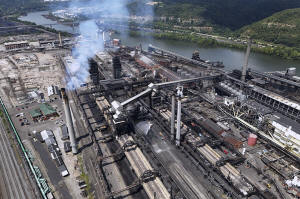Fatal explosion at U.S. Steel's plant raises questions about its future,
despite heavy investment
[August 18, 2025] By
MARC LEVY
HARRISBURG, Pa. (AP) — The fatal explosion last week at U.S. Steel's
Pittsburgh-area coal-processing plant has revived debate about its
future just as the iconic American company was emerging from a long
period of uncertainty.
The fortunes of steelmaking in the U.S. — along with profits, share
prices and steel prices — have been buoyed by years of friendly
administrations in Washington that slapped tariffs on foreign imports
and bolstered the industry's anti-competitive trade cases against China.
Most recently, President Donald Trump's administration postponed new
hazardous air pollution requirements for the nation's roughly dozen coke
plants, like Clairton, and he approved U.S. Steel's nearly $15 billion
acquisition by Japanese steelmaker Nippon Steel.
Nippon Steel's promised infusion of cash has brought vows that
steelmaking will continue in the Mon Valley, a river valley south of
Pittsburgh long synonymous with steelmaking.
“We’re investing money here. And we wouldn’t have done the deal with
Nippon Steel if we weren’t absolutely sure that we were going to have an
enduring future here in the Mon Valley," David Burritt, U.S. Steel’s
CEO, told a news conference the day after the explosion. ”You can count
on this facility to be around for a long, long time.”

Will the explosion change anything?
The explosion killed two workers and hospitalized 10 with a blast so
powerful that it took hours to find two missing workers beneath charred
wreckage and rubble. The cause is under investigation.
The plant is considered the largest coking operation in North America
and, along with a blast furnace and finishing mill up the Monongahela
River, is one of a handful of integrated steelmaking operations left in
the U.S.
The explosion now could test Nippon Steel’s resolve in propping up the
nearly 110-year-old Clairton plant, or at least force it to spend more
than it had anticipated.
Nippon Steel didn't respond to a question as to whether the explosion
will change its approach to the plant.
Rather, a spokesperson for the company said its “commitment to the Mon
Valley remains strong” and that it sent “technical experts to work with
the local teams in the Clairton Plant, and to provide our full support.”
Meanwhile, Burritt said he had talked to top Nippon Steel officials
after the explosion and that “this facility and the Mon Valley are here
to stay.”
U.S. Steel officials maintain that safety is their top priority and that
they spend $100 million a year on environmental compliance at Clairton
alone.
However, repairing Clairton could be expensive, an investigation into
the explosion could turn up more problems, and an official from the
United Steelworkers union said it’s a constant struggle to get U.S.
Steel to invest in its plants.
Besides that, production at the facility could be affected for some
time. The plant has six batteries of ovens and two — where the explosion
occurred — were damaged. Two others are on a reduced production schedule
because of the explosion.
There is no timeline to get the damaged batteries running again, U.S.
Steel said.
Accidents are nothing new at Clairton
Accidents are nothing new at Clairton, which heats coal to high
temperatures to make coke, a key component in steelmaking, and produces
combustible gases as byproducts.
An explosion in February injured two workers.
Even as Nippon Steel was closing the deal in June, a breakdown at the
plant dealt three days of a rotten egg odor into the air around it from
elevated hydrogen sulfide emissions, the environmental group GASP
reported.

[to top of second column] |

A portion of the Clairton Coke Works, a U.S. Steel plant, is seen
Monday, Aug. 11, 2025 in Clairton, Pa. (AP Photo/Gene J. Puskar
 The Breathe Project, a public health
organization, said U.S. Steel has been forced to pay $57 million in
fines and settlements since Jan. 1, 2020, for problems at the
Clairton plant.
A lawsuit over a Christmas Eve fire at the Clairton plant in 2018
that saturated the area’s air for weeks with sulfur dioxide produced
a withering assessment of conditions there.
An engineer for the environmental groups that sued wrote that he
“found no indication that U.S. Steel has an effective, comprehensive
maintenance program for the Clairton plant.”
The Clairton plant, he wrote, is "inherently dangerous because of
the combination of its deficient maintenance and its defective
design."
U.S. Steel settled, agreeing to spend millions on upgrades.
Matthew Mehalik, executive director of the Breathe Project, said
U.S. Steel has shown more willingness to spend money on fines,
lobbying the government and buying back shares to reward
shareholders than making its plants safe.
Will Clairton be modernized?
It's not clear whether Nippon Steel will change Clairton.
Central to Trump’s approval of the acquisition was Nippon Steel’s
promises to invest $11 billion into U.S. Steel’s aging plants and to
give the federal government a say in decisions involving domestic
steel production, including plant closings.
But much of the $2.2 billion that Nippon Steel has earmarked for the
Mon Valley plants is expected to go toward upgrading the finishing
mill, or building a new one.
For years before the acquisition, U.S. Steel had signaled that the
Mon Valley was on the chopping block.
That left workers there uncertain whether they'd have jobs in a
couple years and whispering that U.S. Steel couldn't fill openings
because nobody believed the jobs would exist much longer.

Relics of steelmaking’s past
In many ways, U.S. Steel’s Mon Valley plants are relics of
steelmaking’s past.
In the early 1970s, U.S. steel production led the world and was at
an all-time high, thanks to 62 coke plants that fed 141 blast
furnaces. Nobody in the U.S. has opened a new blast furnace in
decades, as foreign competition devastated the American steel
industry and coal fell out of favor.
Now, China is dominant in steel and heavily invested in coal-based
steelmaking. In the U.S., there are barely a dozen coke plants and
blast furnaces left, as the country's steelmaking has shifted to
cheaper electric arc furnaces that use electricity, not coal.
Blast furnaces won’t entirely go away, analysts say, since they
produce metals that are preferred by automakers, appliance makers
and oil and gas exploration firms.
Still, Christopher Briem, an economist at the University of
Pittsburgh’s Center for Social and Urban Research, questioned
whether the Clairton plant really will survive much longer, given
its age and condition. It could be particularly vulnerable if the
economy slides into recession or the fundamentals of the American
steel market shift, he said.
“I’m not quite sure it’s all set in stone as people believe,” Briem
said. “If the market does not bode well for U.S. Steel, for American
steel, is Nippon Steel really going to keep these things?”
All contents © copyright 2025 Associated Press. All rights reserved |